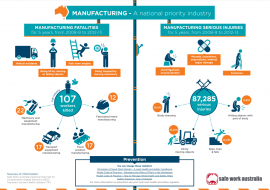This infographic provides information about the causes of the high number of worker fatalities and injuries in the manufacturing industry.

Downloads
In this broad industry group, the sectors with most fatalities are machinery and equipment manufacturing, food product manufacturing, transport equipment manufacturing, and fabricated metal manufacturing.
Because of the high levels of work-related death and injury to manufacturing workers, this industry is a national priority under the Australian Work Health and Safety Strategy 2112-2022.
Manufacturing fatalities
In the five years from 2008–9 to 2012–13, there were 107 manufacturing workers killed. The most common causes of fatalities were vehicle incidents, being hit by moving or falling objects, falls from heights and being trapped by moving machinery.
The following table shows the manufacturing sub-sectors with the highest numbers of workers killed:
|
Industry Sub-sector |
Number of workers killed |
|
Machinery and equipment manufacturing |
22 |
|
Transport equipment manufacturing |
17 |
|
Food product manufacturing |
17 |
|
Fabricated metal manufacturing |
12 |
Manufacturing serious injuries
In the five years from 2008–9 to 2012-13 there were 87,285 serious injuries reported. The most common types of injury were joint/ligament, muscle/tendon, wounds, lacerations, amputations, internal organ damage, and fractures.
The following table shows the main causes of serious injuries:
|
Cause of injury |
Number of serious injuries |
|
Body stressing |
39,410 |
|
Hit by moving objects |
16,450 |
|
Slips, trips and falls |
14,235 |
|
Hitting objects with part of the body |
8,935 |
Sources of information
Safe Work Australia’s national dataset for compensation-based statistics
Traumatic Injuries Fatality dataset
Who is this presentation for?
Business owners and managers in the manufacturing industry will find it very useful to know where to start to manage the key hazards facing their workers. Teachers and trainers who are preparing workers for this industry sector will also benefit from understanding the most serious hazards their students face.
Supporting information
- Work-related traumatic injury fatalities
- Incidence rates and frequency rates of serious claims by industry, 2011–12 to 2014–15
- Australian Work Health and Safety Strategy 2012–2022
Some solutions
- model code of practice – Managing the risks of plant in the workplace
- model code of practice – How to manage work health and safety risks
- Injury hotspots – WorkSafe Victoria interactive infographics
For more information on prevention see your local work health and safety regulator.
Publication Date:
Last updated:
Publication type:
